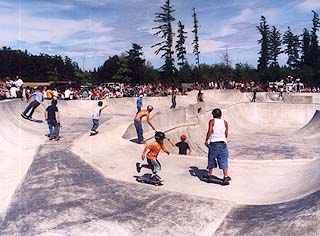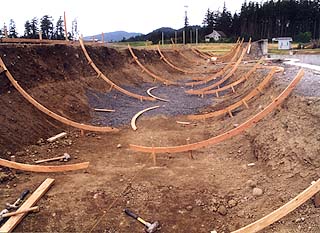|
Subscribe / Renew |
|
|
Contact Us |
|
| ► Subscribe to our Free Weekly Newsletter | |
| home | Welcome, sign in or click here to subscribe. | login |
Construction
| |
 |
May 2, 2003
Skate park shreds gnarly drug dealers
Special to the Journal

Photos courtesy of Warren Miller
A new skateboard park on Orcas Island has been so well received that more bleachers have been added.
|
Four years ago, a survey revealed that the drug and alcohol problem among high school students on Orcas Island was twice the state average. It revealed that 73 percent of the local high school seniors drink two or more times a month and 53 percent use drugs two or more times a month.
A group of us who live in the Orcas Island community felt that a skateboard park might be part of the answer to the drug problem.
In a skateboard park there is no score and anyone who rides there is a winner. After one skates for just an hour or so, he or she is often too tired to even think about drugs or alcohol.
We set out three years ago to raise $100,000 to build a 10,000-square-foot concrete park. It expanded to 22,000 square feet, since we were able to raise over $230,000.
There are many skateboard parks in America today that have a flat concrete slab with wooden ramps, and the many problems of using wood are obvious. There is also a company that manufactures stainless steel ramps that can be placed on any slab, which provide different kinds of problems.
Our Orcas Island Skateboard Park committee immediately dismissed these two materials in favor of using only concrete. We also realized that we knew nothing about skateboarding or how to build a park. After researching other parks, we knew that the finished park would depend entirely on the creative ideas and skill of the contractor that we eventually would choose.
After interviewing half a dozen skateboard park contractors via e-mail, fax, phone and in person, we settled on Grindline of West Seattle for several reasons:
- This would be Grindline owner Mark Hubbard’s 23rd concrete skate park.
- He and his crew would not require expensive hotel rooms and meals, rather they would live in tents, trailers and vans during the three months of construction. This allowed all of the money we raised to go directly into concrete, rebar, form lumber and labor.
- Grindline also liked the idea that our committee would not interfere in their design or construction ideas in any way. They were the experts and we would stand back and let them build an ultimate concrete skateboard park.
The project got under way in early May 2002, even though our committee had only raised $65,000. We believed that once construction was started, the additional money would be donated — and it was.
The local superintendent of schools, Barry Acker, donated 10,000 square feet of land, but we eventually raised enough money for a 22,000-square-foot world-class skateboard park and he let us build it that big.
We were able to do this because Paul Garwood, the owner of the local lumberyard with 20 years of experience constructing concrete buildings in Southern California, was the pro bono contractor during the entire job.
Local cooperation had never been as good as on this project:
- Orcas Excavation donated all of the equipment and labor for the excavation.
- Loren Ray, a local contractor, raised $16,000 to buy some of the over 500 yards of concrete.
- Sea Island Sand and Gravel furnished concrete and donated extra pump time. The firm also bought and installed a special valve that fit on the end of the concrete pump and converted the pump into a gunite-like machine. This enabled a dryer concrete mix to be blown on all of the surfaces — from horizontal to beyond vertical. This saved us the cost of renting a gunite machine for about 45 days.
- Island Excavation loaned its gigantic 45-foot excavator whenever we needed it.
- Dozens of volunteers took time off from their jobs, and showed up on site to finish concrete on the days we poured it. Some of them even paid $30 for a 6 a.m. ferry ride to Orcas Island to finish concrete all day at no pay. There were days when as many as 17 concrete finishers were on the job with only six of them on the payroll.
- Residents on the island who owned backhoes, bobcats, excavators, compactors, chain saws, dump trucks and assorted other power tools donated them for as long as the project needed them.
- Alki Lumber in West Seattle donated almost 40,000 feet of ½-inch rebar for the park.
- Local heavy-machine operators took days off from work and donated thousands of dollars worth of heavy-machinery operation time.
Is the skateboard park working?
A resounding yes! We had to buy two extra sets of bleachers to handle the many moms and families who sit in the sun daily and watch their young children skate hour after hour. Immediately after the park opened, a group of 50-year-old contractors and tradesmen bought skateboards — along with helmets, knee pads, elbow pads, wrist pads and finally ice hockey hip pads — and now skate every morning before work. One 49-year-old carpenter told me that he has lost 30 pounds and hasn’t had to go to the chiropractor for the last five months.
Has the concrete park decreased the drug and alcohol problem?
I don’t have the answer to that yet, but I do hear some of the young kids talk about how tired they are from skateboarding and don’t need to get high on drugs or alcohol anymore.

Radiused screed boards were created by attaching a skill saw to a 2-by-4 and cutting plywood. |
The local newspaper has called the construction of the park, “One of the 10 most important things that happened on Orcas Island in 2002.” It already has a reputation of being the best skateboard park in the Northwest and one of the five best in the world.
Mark Hubbard and his crew built the park without a working drawing of any kind. It all was sculpted from their brains in concert with each other.
The Seattle YMCA camp on Orcas Island is offering Freedom Camps this summer where kids will spend their week skateboarding, mountain bike riding, sea kayaking and sailing.
This skateboard park is different than any other piece of creative art, because this one is changing the lives of anyone who rides it. It has 2 million pounds of concrete that is sculpted for the enjoyment of generations to come.
Almost every day that 2 million pounds of concrete is brought alive by the sound of rolling wheels and the excited voices of the young people who are finding their own individual freedom on its sculptured surface.
Filmmaker Warren Miller has spent 55 years capturing on film “freedom-oriented” sports — where no score is kept, such as skiing, sailing, kayaking and skateboarding. He also has authored a half dozen books and writes a column for a number of small papers.
Other Stories:
- Nix the blisters for a smooth complexion
- Post-tension that concrete building?
- Scenic canyon tests concrete’s beauty


